Calming herbal tea blends, like chamomile and lavender, tap into ancient wisdom to provide you with modern relief. These natural remedies are great for reducing stress, promoting relaxation, and enhancing overall well-being. Ingredients like lemon balm and valerian root further support your quest for calm, offering soothing properties that ease anxiety and improve sleep. To craft your own blend, simply mix your favorite herbs, steep them properly, and enjoy the tranquility they bring. By exploring more about these herbal treasures, you'll discover how they can transform your daily routine into a peaceful experience.
The Importance of Herbal Teas
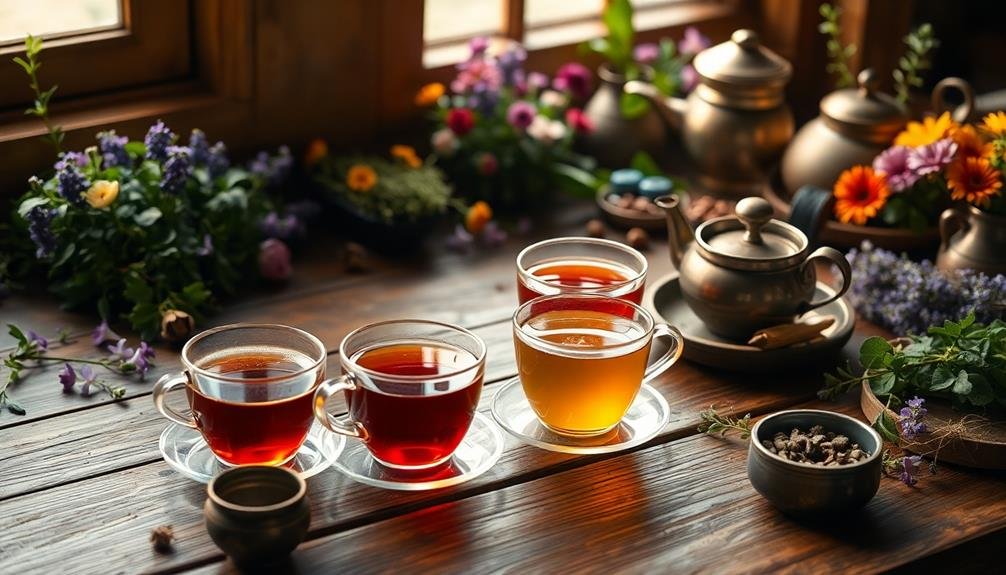
Herbal teas pack a punch when it comes to health benefits, making them an essential part of your wellness routine. These delightful brews offer more than just a soothing sip—they're packed with antioxidants, vitamins, and minerals that can enhance your overall health.
When you incorporate herbal teas into your daily life, you're not just enjoying a warm drink; you're also reaping the rewards of natural remedies that have been used for centuries.
You might find that certain herbal blends can help reduce stress, improve digestion, or support your immune system. For example, chamomile is well-known for its calming properties, making it perfect for winding down after a long day. Peppermint can aid in digestion, while ginger tea can help boost your metabolism.
Additionally, herbal teas can be a great alternative to sugary beverages, allowing you to stay hydrated without added calories. By choosing herbal teas, you're making a conscious decision to prioritize your health and well-being.
Ancient Practices of Herbal Remedies
When you explore ancient practices of herbal remedies, you'll discover how traditional healing methods have shaped cultures around the world.
These herbs weren't just ingredients; they held significant meaning and were often central to rituals and health.
Understanding their historical context can deepen your appreciation for the calming effects of herbal tea blends today.
Traditional Healing Methods
For centuries, cultures around the world have turned to nature's bounty for healing, utilizing plants not just for their flavors but for their medicinal properties as well. You might be surprised to learn how many traditional healing methods have stood the test of time, offering remedies that address both physical and emotional ailments.
Take chamomile, for instance. This gentle flower has been used since ancient Egypt to reduce anxiety and promote sleep. When you sip on a warm chamomile tea, you're not just enjoying a pleasant taste; you're also tapping into centuries of wisdom.
Similarly, valerian root has long been celebrated for its calming effects, often found in nighttime teas designed to help you unwind after a long day.
Peppermint is another staple, known for soothing digestive issues while also invigorating your mind. Incorporating these herbal remedies into your routine can provide you with a natural means to alleviate stress and promote relaxation.
In a world filled with synthetic solutions, embracing these traditional methods can restore a sense of balance and well-being, reminding you of the power nature holds in healing.
Cultural Significance of Herbs
Embracing the rich tapestry of cultural significance surrounding herbs reveals profound insights into ancient practices of herbal remedies. Across various cultures, herbs have served not just as healing agents but also as symbols of connection to nature and spirituality.
You'll find that ancient civilizations, from the Egyptians to the Chinese, relied on specific herbs to treat ailments, celebrate rituals, and promote well-being.
In many indigenous cultures, herbs were seen as sacred gifts from the earth, often used in ceremonies to honor ancestors and the natural world. You might appreciate how these traditions emphasized balance and harmony, reflecting a holistic approach to health.
As you explore herbal tea blends today, consider the stories behind each ingredient. For instance, chamomile, celebrated for its calming properties, has been used since ancient times to soothe the mind and body.
Similarly, peppermint has roots in various cultures as a digestive aid and invigorating herb. By understanding the cultural significance of these herbs, you can deepen your appreciation for their modern applications while honoring the wisdom of those who came before you.
Embracing this heritage enriches your experience with herbal remedies today.
Key Ingredients for Calmness
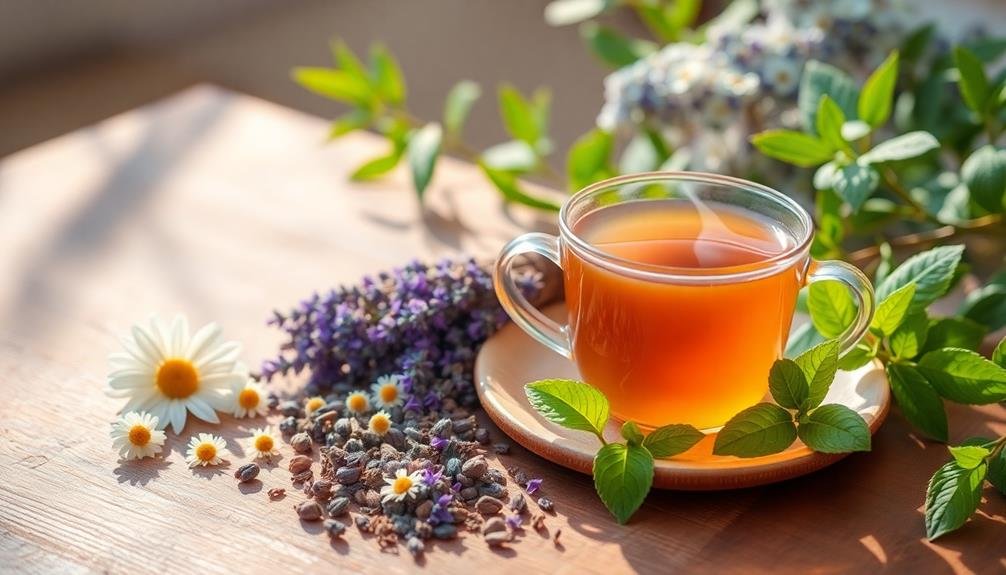
While many people seek solace in a warm cup of tea, the right herbal ingredients can greatly enhance your sense of calm. Chamomile is a classic choice; its gentle, soothing properties can help ease anxiety and promote relaxation. You'll find it's especially effective before bedtime, making it a staple in many calming blends.
Lavender is another fantastic ingredient. Its floral aroma not only smells divine but also helps reduce stress and improve mood. You might enjoy adding a few dried lavender buds to your tea for that extra layer of tranquility.
Lemon balm is known for its calming effects, too. This herb has been used for centuries to alleviate feelings of restlessness and anxiety. When combined with other herbs, it can create a deliciously invigorating blend.
Lastly, consider valerian root. It's a powerful herb that promotes sleep and relaxation, making it an excellent addition for those particularly stressful days.
Preparing Your Herbal Tea Blend
Now that you have a good grasp of the key ingredients for a calming herbal tea, it's time to put those into action by preparing your own blend.
Start by selecting your base herbs. Popular choices include chamomile, lemon balm, and lavender. Measure about one tablespoon of each herb for a single serving, adjusting according to your taste.
Next, combine your herbs in a bowl. You can mix and match to find the perfect balance—experimenting is part of the fun!
Once you have your blend ready, it's time to brew. Boil water and let it cool for a minute or two; the ideal temperature is around 200°F. Pour the hot water over your herb mixture in a teapot or a heatproof container.
Cover the blend and steep for about 5 to 7 minutes. This allows the flavors and soothing properties to fully infuse into the water.
After steeping, strain the tea into your favorite cup. Feel free to sweeten it with honey or add a splash of lemon if you like.
Enjoy your calming herbal tea as a comforting ritual to unwind at the end of the day.
Chamomile: A Timeless Soother

Chamomile, often considered a timeless soother, has been cherished for centuries for its calming properties. When you brew a cup of chamomile tea, you're not just enjoying a warm beverage; you're embracing a tradition that dates back to ancient civilizations. This gentle herb, derived from the flowers of the chamomile plant, is known for its ability to promote relaxation and improve sleep quality.
As you sip your chamomile tea, you may find that its subtle, sweet flavor is both comforting and soothing. The active compounds in chamomile, such as apigenin, interact with your brain's receptors, helping to reduce anxiety and induce sleepiness. It's an ideal choice for those evenings when you need to unwind after a long day.
In addition to its calming effects, chamomile boasts anti-inflammatory and digestive benefits. If you've ever experienced an upset stomach or bloating, a warm cup of chamomile can help ease those discomforts.
Lavender: Serenity in a Cup
Lavender's soothing aroma and vibrant purple hue make it a beloved choice for those seeking tranquility. When you brew a cup of lavender tea, you invite a moment of calm into your day. This herbal wonder has been cherished for centuries, known for its ability to alleviate stress and promote relaxation.
As you sip, you'll notice the delicate floral notes enveloping your senses, gently easing tension and quieting your mind. Lavender is rich in antioxidants, which can help support your overall well-being, while its natural sedative properties may assist in improving sleep quality.
Incorporating lavender into your routine is easy. You can enjoy it alone or blend it with other calming herbs, like chamomile or lemon balm, to enhance its soothing effects.
Whether you're winding down after a long day or preparing for a restful night's sleep, a warm cup of lavender tea can be your perfect companion.
Peppermint: Refreshing Relief
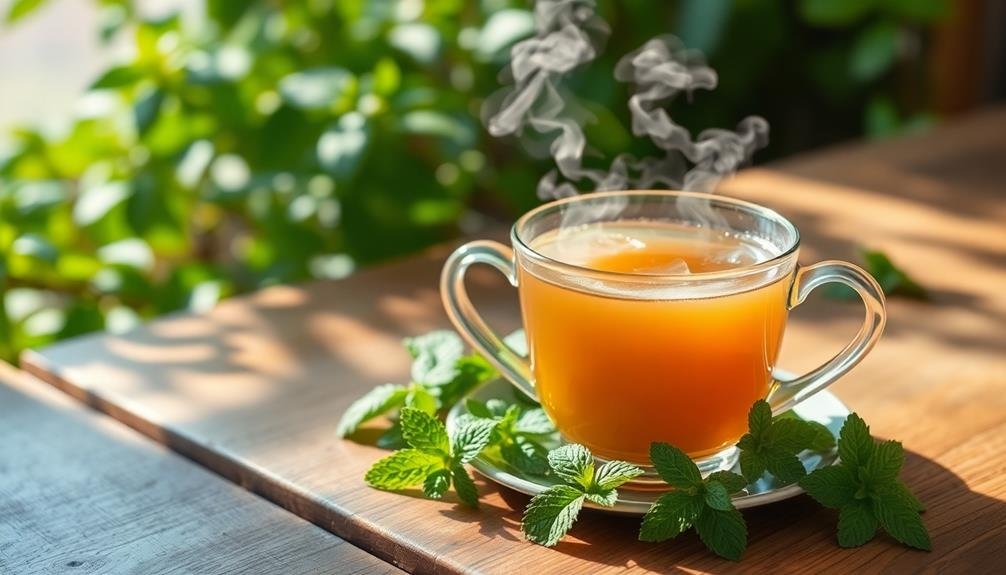
After indulging in the calming effects of lavender, you might find that peppermint offers a revitalizing contrast. This herb isn't just invigorating; it's packed with benefits that can help clear your mind and boost your energy. If you're feeling sluggish or mentally foggy, a cup of peppermint tea can work wonders to lift your spirits.
Peppermint contains menthol, which can provide a cooling sensation that stimulates your senses. As you sip, you'll notice how the aroma alone can awaken your senses and help you focus. It's an excellent choice for those moments when you need to shake off fatigue or enhance mental clarity.
Additionally, peppermint tea can aid digestion, making it a great choice after meals. If you've overeaten or just feel bloated, this herbal tea can soothe your stomach and promote a feeling of comfort.
Lemon Balm: Nature's Chill Pill
Lemon balm's soothing properties make it a favorite among those seeking a natural way to unwind. This delightful herb, with its bright green leaves and gentle lemon scent, has been treasured for centuries for its calming effects.
When you brew a cup of lemon balm tea, you're not just enjoying a pleasant beverage; you're tapping into a long-standing tradition of relaxation.
Known for its ability to reduce anxiety and promote a sense of calm, lemon balm works wonders when you're feeling stressed or overwhelmed. It's particularly effective in easing tension and helping you find your center.
You might find that sipping on this herbal tea before bedtime helps quiet your racing thoughts, making it easier to drift off to sleep.
In addition to its calming effects, lemon balm's delicate flavor adds a revitalizing twist to tea blends. You can combine it with other soothing herbs, like chamomile or lavender, to enhance its relaxation properties.
Valerian Root: Sleep Aid Power
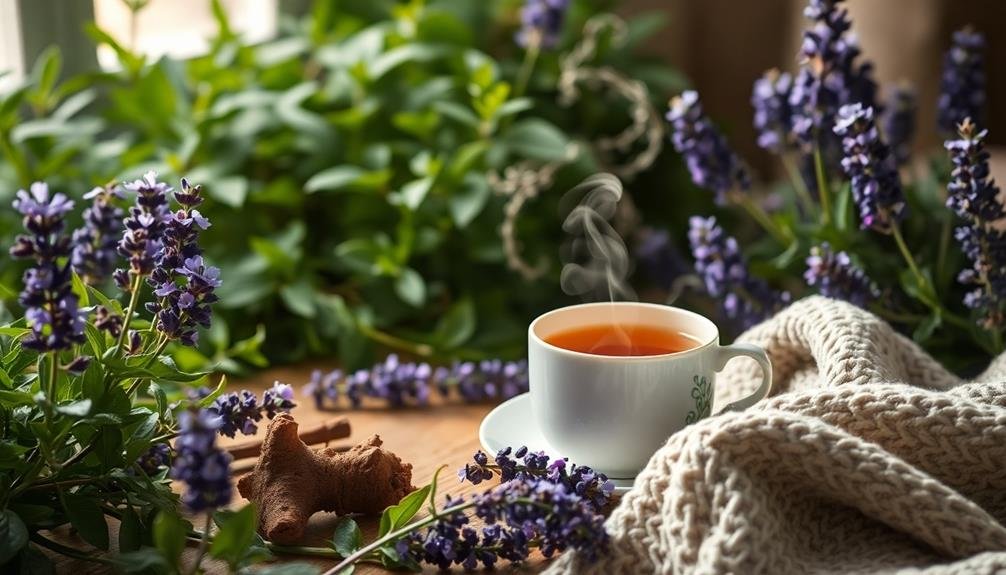
When the sun sets and the day's worries linger, valerian root emerges as a powerful ally for those seeking restful sleep. This ancient herb has been used for centuries to promote relaxation and improve sleep quality. If you've struggled with insomnia or restless nights, valerian root might just be your solution.
Here's a quick comparison of valerian root's benefits:
| Benefit | How It Helps | Recommended Use |
|---|---|---|
| Reduces Anxiety | Calms the mind, easing stress | Drink tea 30 minutes before bed |
| Improves Sleep Quality | Enhances deep sleep cycles | Combine with chamomile for best results |
| Shortens Time to Sleep | Helps you fall asleep faster | Use daily for cumulative effect |
Incorporating valerian root into your evening routine can create a serene atmosphere that encourages sleep. Whether you choose a tea blend or a tincture, make it part of your nightly ritual. Just remember to consult with a healthcare professional before starting any new herbal treatment, especially if you're taking medications. With valerian root, restful nights could be just a sip away.
Adaptogens for Stress Relief
As stressors pile up in daily life, incorporating adaptogens into your routine can provide the support you need to maintain balance. Adaptogens are natural substances that help your body adapt to stress, promoting a sense of calm and stability. Herbs like ashwagandha, rhodiola, and holy basil are renowned for their ability to enhance your resilience against stress.
When you consume adaptogens, you're not just soothing your nerves; you're also supporting your body's overall stress response. For instance, ashwagandha may lower cortisol levels, the hormone responsible for your stress reactions. Rhodiola can boost your energy and improve mental clarity, making it easier to tackle overwhelming tasks.
Holy basil, with its grounding properties, can help you feel more centered amidst chaos.
Incorporating these herbs into your day can be simple. You might enjoy them in tea blends or capsules, allowing you to choose what fits best into your lifestyle.
Crafting Your Own Blends
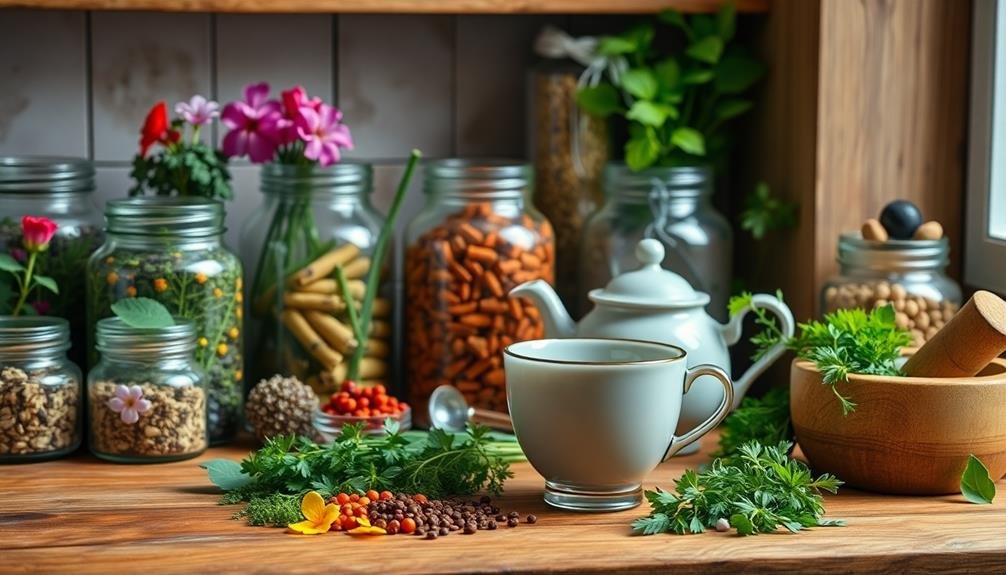
Creating your own herbal tea blends can be a fun and rewarding experience that allows you to tailor flavors and benefits to your preferences. Start by choosing a base herb, such as chamomile for calmness or peppermint for a revitalizing taste.
Think about what you want to achieve with your blend—relaxation, digestion, or perhaps a mood boost.
Next, add complementary herbs. For example, if you choose chamomile, consider mixing it with lavender for added tranquility or lemon balm for a touch of sweetness. Experiment with proportions to find the perfect balance. You might find that a 2:1 ratio of chamomile to lavender works well for you, but don't be afraid to adjust until it feels just right.
Once you've crafted your blend, let it steep for a few hours or overnight to fully infuse the flavors.
Take note of how the blend makes you feel, and adjust your ingredients accordingly for future batches. Remember, crafting your own herbal tea blends is all about experimentation and personal expression, so enjoy the process and sip your way to serenity!
Tips for Optimal Brewing
To brew the perfect calming herbal tea, start by choosing quality ingredients that enhance flavor and benefits.
Pay attention to brewing temperature, as it can greatly affect the infusion process.
Choosing Quality Ingredients
When it comes to brewing a calming herbal tea, selecting high-quality ingredients is essential for achieving the best flavor and benefits. You want to guarantee that the herbs you choose are fresh, organic, and sourced from reputable suppliers. This not only enhances the taste but also maximizes the therapeutic properties of the tea.
Here are some tips for choosing the right ingredients:
| Quality Indicator | What to Look For |
|---|---|
| Freshness | Vibrant colors, fragrant aroma |
| Organic Certification | USDA Organic label |
| Whole Herbs | Loose leaf over tea bags |
| Local Sourcing | Check for regional suppliers |
| Packaging | Airtight, light-resistant containers |
Brewing Temperature Matters
The quality of your ingredients sets the stage for a delicious cup of calming herbal tea, but the brewing temperature plays a significant role in releasing their full potential. Different herbs thrive at varying temperatures, so knowing which temperature to use can enhance your tea's flavor and benefits.
For delicate herbs like chamomile or lavender, aim for a lower brewing temperature of around 190°F (88°C). This gentler heat extracts the subtle flavors without overpowering the delicate compounds.
If you're using heartier herbs, like peppermint or ginger, you can crank up the heat to about 212°F (100°C) to fully release their robust flavors and health benefits.
Always preheat your teapot or mug to maintain the desired temperature during brewing. Pouring boiling water into a cold vessel can lower the temperature, affecting extraction.
Additionally, using a thermometer can help guarantee you're hitting the right mark; precision matters here.
Steeping Time Importance
Getting the steeping time right is essential for brewing the perfect cup of calming herbal tea. The right duration can release the full potential of the herbs, allowing their flavors and benefits to shine. Typically, you'll want to steep your herbal tea for about 5 to 7 minutes, but this can vary depending on the blend.
Start by checking the specific recommendations for your tea blend, as some herbs may require longer steeping times to let go of their properties. For instance, chamomile might only need 5 minutes, while a more robust blend, like rooibos, could benefit from a full 7 minutes or more.
If you steep it for too short a time, you risk missing out on those soothing qualities. On the other hand, over-steeping can lead to bitterness.
To keep track, set a timer when you start brewing. After steeping, taste your tea to see if it meets your preferences. Adjust the time accordingly for your next cup.
Experimenting with steeping times can help you discover the perfect balance, ensuring each cup is as calming and delicious as possible. Enjoy your herbal journey!
Storing and Enjoying Your Teas
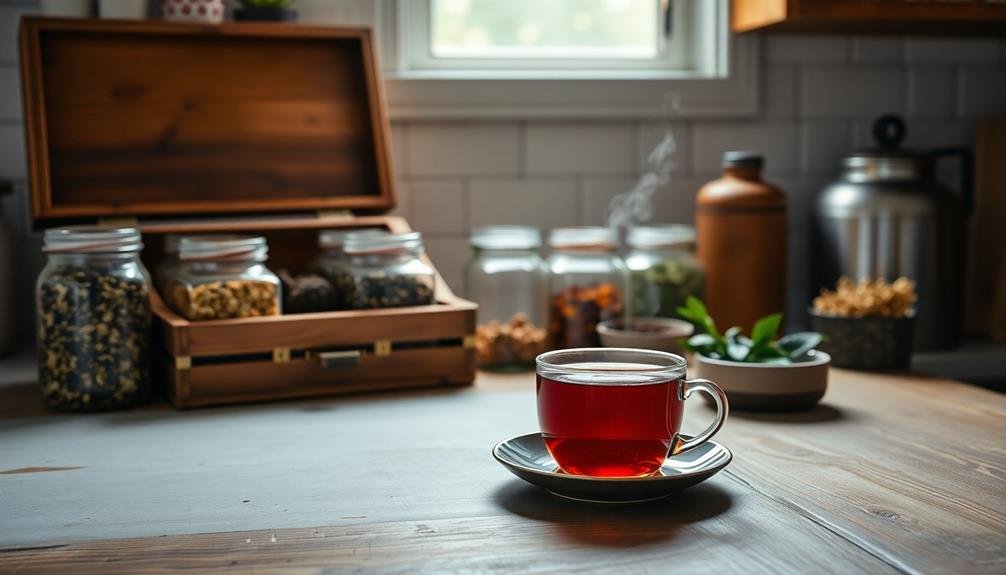
Proper storage and enjoyment of your calming herbal tea blends can greatly enhance your experience. Start by keeping your teas in an airtight container, away from light, moisture, and strong odors. Glass jars or metal tins work best, as they protect the delicate herbs and preserve their flavors.
Label the containers with the date you opened them, and use your teas within six months for ideal freshness.
When you're ready to enjoy a cup, boil fresh, filtered water to release the full essence of your blend. Measure out the recommended amount of tea according to your taste and steep it for the right duration.
Don't rush this process; allow the ingredients to mingle and infuse fully, creating a soothing experience.
For added enjoyment, consider personalizing your tea ritual. Use your favorite mug, add a splash of honey or a slice of lemon, and take a moment to breathe in the aroma before sipping.
This mindful practice not only enhances the flavor but also promotes relaxation. Remember, your calming herbal tea isn't just a drink; it's a moment of tranquility in your busy day. Savor it!
Frequently Asked Questions
Can Herbal Teas Interact With Prescription Medications?
Yes, herbal teas can interact with prescription medications. They might enhance or reduce the effectiveness of your meds. It's essential to consult your doctor before adding any herbal tea to your routine to guarantee safety.
Are There Any Side Effects From Drinking Herbal Teas Daily?
Drinking herbal teas daily can lead to side effects like digestive issues, headaches, or allergic reactions. It's crucial to pay attention to your body and consult a healthcare professional if you notice any adverse effects.
How Much Herbal Tea Is Safe to Consume in a Day?
You can safely enjoy 2 to 3 cups of herbal tea daily. However, it's wise to check specific herbs for potential interactions or side effects, as some might not be suitable for everyone. Always listen to your body!
Can Children Drink Herbal Teas Safely?
Yes, children can drink herbal teas safely, but it's important to choose caffeine-free options and consult a pediatrician. You should monitor their reactions and ascertain the herbs are appropriate for their age and health.
What Are the Best Times to Drink Calming Herbal Teas?
You should drink calming herbal teas in the evening, before bed, or during stressful moments. They help unwind your mind, promote relaxation, and prepare your body for restful sleep or a peaceful day ahead.
In Summary
Embracing the calming power of herbal tea blends connects you with ancient wisdom while offering modern relief. By exploring key ingredients and crafting your own blends, you create personalized rituals that soothe both mind and body. Remember to brew with care and store your teas properly to maintain their potency. So, the next time stress creeps in, pour yourself a cup of tranquility and enjoy the comforting embrace of nature's finest remedies. Cheers to your well-being!

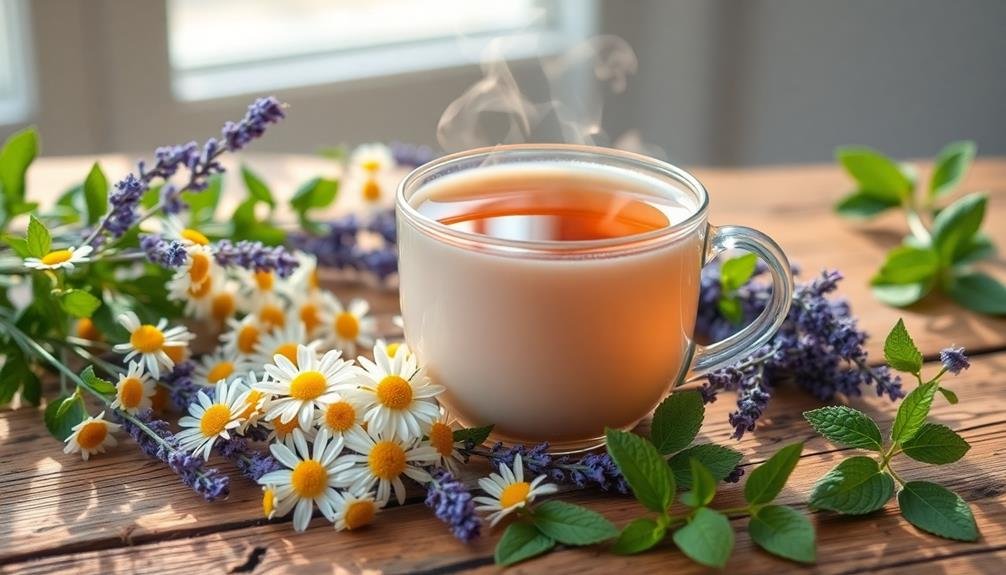
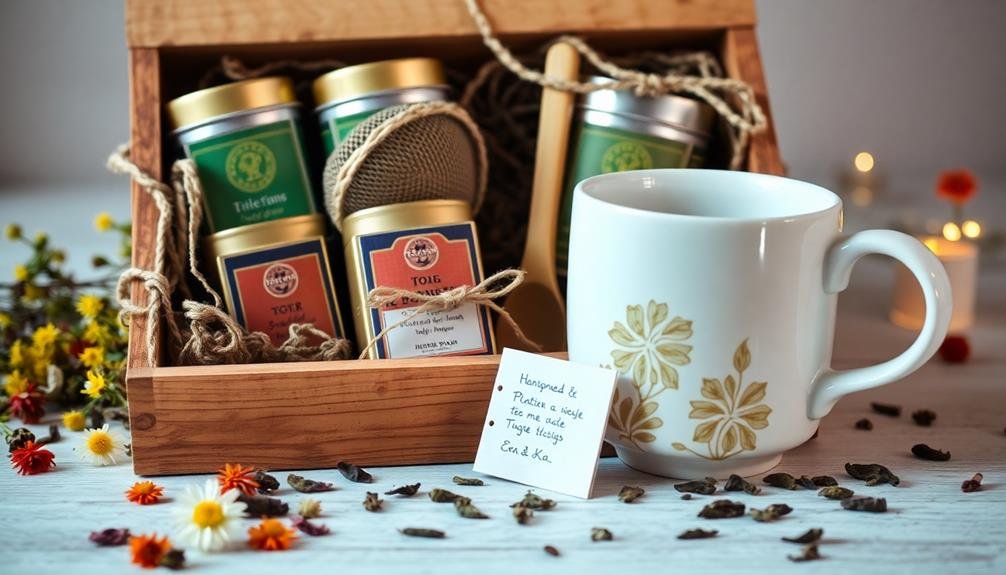
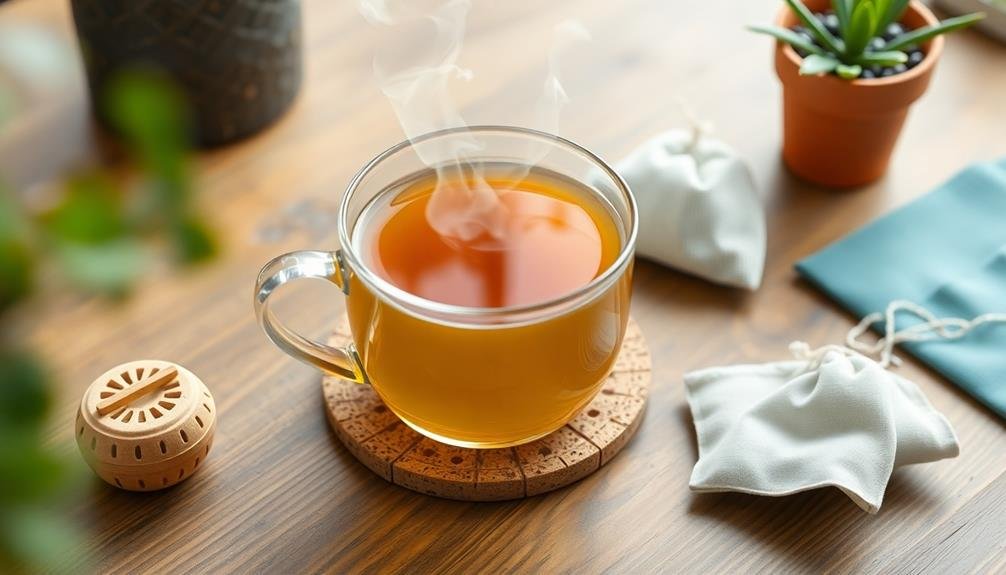
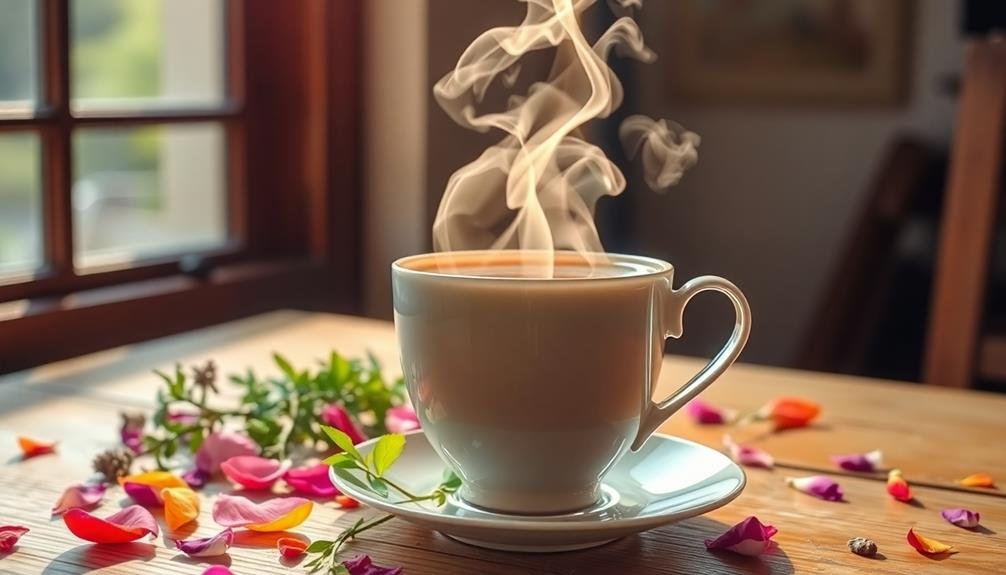
Leave a Reply